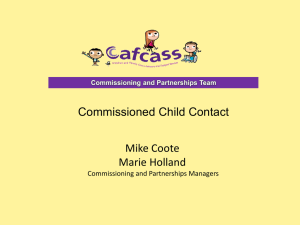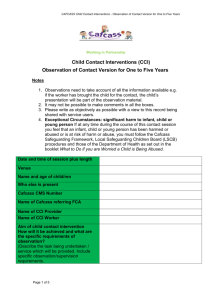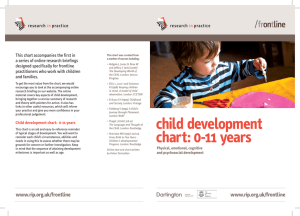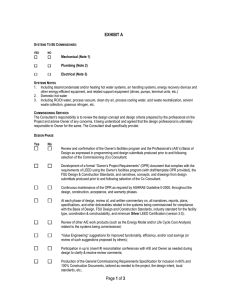Observation and Intervention Guidance
advertisement
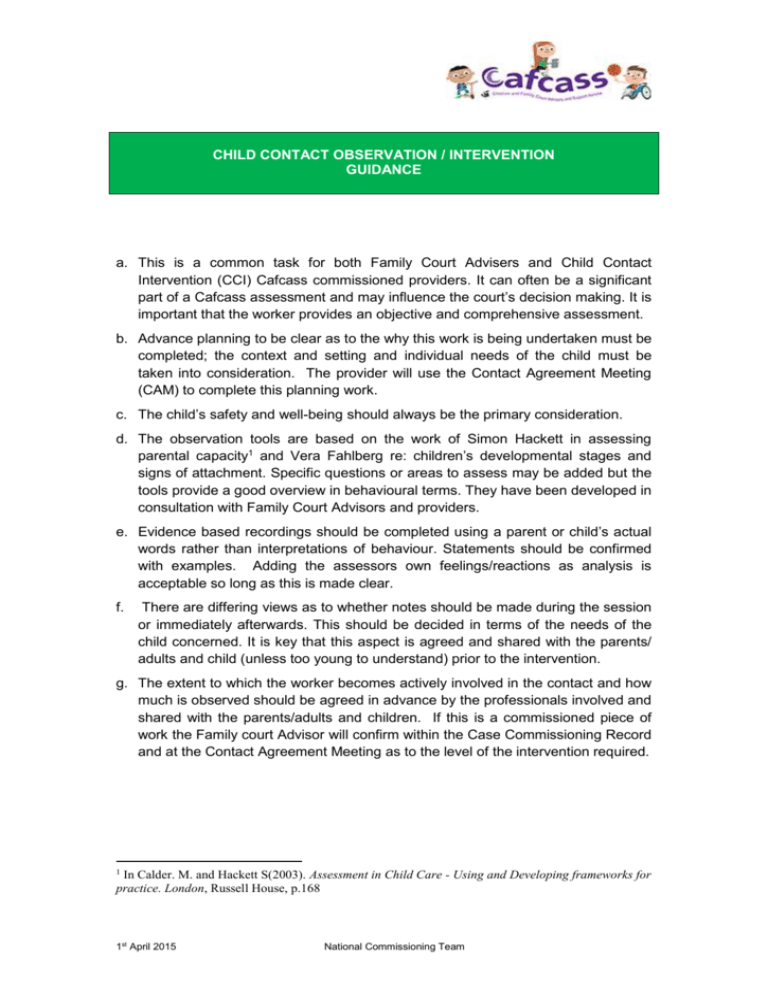
CHILD CONTACT OBSERVATION / INTERVENTION GUIDANCE a. This is a common task for both Family Court Advisers and Child Contact Intervention (CCI) Cafcass commissioned providers. It can often be a significant part of a Cafcass assessment and may influence the court’s decision making. It is important that the worker provides an objective and comprehensive assessment. b. Advance planning to be clear as to the why this work is being undertaken must be completed; the context and setting and individual needs of the child must be taken into consideration. The provider will use the Contact Agreement Meeting (CAM) to complete this planning work. c. The child’s safety and well-being should always be the primary consideration. d. The observation tools are based on the work of Simon Hackett in assessing parental capacity1 and Vera Fahlberg re: children’s developmental stages and signs of attachment. Specific questions or areas to assess may be added but the tools provide a good overview in behavioural terms. They have been developed in consultation with Family Court Advisors and providers. e. Evidence based recordings should be completed using a parent or child’s actual words rather than interpretations of behaviour. Statements should be confirmed with examples. Adding the assessors own feelings/reactions as analysis is acceptable so long as this is made clear. f. There are differing views as to whether notes should be made during the session or immediately afterwards. This should be decided in terms of the needs of the child concerned. It is key that this aspect is agreed and shared with the parents/ adults and child (unless too young to understand) prior to the intervention. g. The extent to which the worker becomes actively involved in the contact and how much is observed should be agreed in advance by the professionals involved and shared with the parents/adults and children. If this is a commissioned piece of work the Family court Advisor will confirm within the Case Commissioning Record and at the Contact Agreement Meeting as to the level of the intervention required. 1 In Calder. M. and Hackett S(2003). Assessment in Child Care - Using and Developing frameworks for practice. London, Russell House, p.168 1st April 2015 National Commissioning Team Key Considerations The context and tasks of contact Degree of existing relationship between adult and child – whether the observation/intervention is taking place after a long period of separation between parent/adult and child or where the direct relationship has been briefly disrupted. What explanation the child has been given regarding the reasons for professional intervention and observations. Tasks/aims set for the intervention. If intervention is being used to re-introduce the child to a parent/adult after a long period of separation, the aims and tasks will be different to when it is being used to assess the ability of the parent/adult to be proactive in providing a stimulating/safe experience for the child. The effect of the setting – is the child likely to be relaxed in these surroundings; has he or she had the chance to get to know the setting? Is the parent/adult familiar with the room if in Cafcass or other official premises? If the intervention/observation is at the home of the other parent or his/her family, what effect will that have on the nervousness/responses of the parent being observed or the child’s reactions The Needs of the child Developmental stage of the child2 (see resources in Footnote). It is important that the child’s responses are observed with a full understanding of the key developmental stages and that the worker also observes whether the parent shows understanding of this. Any special needs of the child – health, communication issues etc. If any of those taking part are not communicating in their first language how does this affect the interaction? Any cultural issues - what is “normal” in this family, e.g. about demonstrating affection? Parental Capacity The parent’s ability during the course of the session to meet the child’s needs; respond to his/her wishes etc. The parent’s/adult’s capacity for emotional warmth without making undue demands of the child in terms of a response. Ability to set appropriate boundaries etc. 2 Sheridan, M. (2000) Department of Health Assessment Framework, Practice Guidance and Fahlberg, V (1994); A Child’s Journey through placement (BAAF) 1st April 2015 National Commissioning Team Ability to put the child’s needs first rather than express anger or frustration with the situation or other parent. The recording forms There are four versions of the recording format based on age/developmental understanding as follows: a. Birth to 1 year b. Pre-school children 1-5 c. Primary school children 5-11 d. Teenagers However it may be that the intervention/observation is of a sibling group and one form will be used. It is key that the reactions of children as individuals are noted. 1st April 2015 National Commissioning Team

